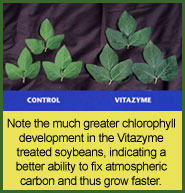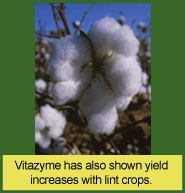
Field TestsVitazyme has undergone over 700 trials on various crops—tropical and subtropical climates on tomatoes, onions, string beans, bush beans, cucumbers, peanuts, cabbage, cow peas, peppers, sweet potatoes, various fruits, sugar cane, oil palm, cassava, forage crops for livestock, and even fish farms, all with excellent results. Temperate climate trials have been done on cotton, peas, snap beans, soybeans, corn, wheat, barley, canola, sugar beets, cabbage, squash, pumpkins, onions and potatoes with equally good results. Vitazyme was first tested in 1995 and is currently used in US, Canada, Mexico, Cuba, Ecuador, Chile, Australia, New Zealand, Vietnam, Indonesia, Philippines, England, Austria, Slovakia, Ukraine, Russia, Ghana, Kenya, Tanzania, South Africa and South Korea. Vitazyme Field Trials Index from 1996 to 2008 [pdf 448KB] For a .pdf version of the full yearly Field Trials Results, click on the year below. See the results for 2011 [pdf 7.2MB] See the results for 2010 [pdf 7MB] See the results for 2009 [pdf 11MB] See the results for 2008 [pdf 2.4MB] See the results for 2007 [pdf 4.2MB] See the results for 2006 [pdf 2.7MB] See the results for 2005 [pdf 1.7MB] See the results for 2004 [pdf 2.5MB] See the results for 2003 [pdf 4MB] See the results for 2002 [pdf 7MB] See the results for 2001 [pdf 8.5MB] See the results for 2000 [pdf 1.7MB] See the results for 1999 [pdf 1MB] See the results for 1998 [pdf 1.5MB] See the results for 1997 [pdf 2MB] See the results for 1996 [pdf 3MB] Below is an incomplete list of Field Tests and Crop Results that used Vitazyme. BermudagrassTest 1 - A sod field was treated by sprayer in one part with Vitazyme and the rest of the field was left untreated. A 1% Vitazyme solution was sprayed on the treated area on April 2, 2003. On May 28, 2003, 56 days after Vitazyme application, four 3-inch cores were collected on each side of the dividing line of the treatments. The cores were thoroughly washed clean of all soil on roots blotted to relative dryness with paper towels and weighed. The data were analyzed by Analysis of Variance using Cohort software. FieldbeansTest 1 - Afield of small red beans was treated conventionally except for a strip through the center of the field that received Vitazyme. The seeds were treated with a 5% Vitazyme solution before planting, plus 13 oz/acre sprayed on the soil after planting, and another 13 oz/acre sprayed on the leaves and soil at early bloom. Two 2.5-acre strips in the Vitazyme strip were harvested and weighed, and compared to the untreated control yield, from which 18 acres was combined and weighed. Test 2 - A fairly uniform 20-acre field was divided into control (8 acres) and Vitazyme treated (12 acres) areas. Soils in both areas were relatively equivalent, with 40% white soils in each area. Navy BeansTest 1 - A field of Navy beans was treated with Vitazyme except for a strip that received none. At planting, Vitazyme (13 oz/acre) plus molasses (0.5 gal/acre) and liquid fish (2 gal/acre) were applied. At early bloom(late July) Vitazyme was again applied at 13 oz/acre, along with 0.5 gal/acre liquid fish, on the leaves and soil. This late application was made to both the control and Vitazyme treatments. PotatoesTest 1 - A center pivot irrigated field was divided into Vitazyme treated and untreated areas for three different in-row spacings — 9, 10, and 11 inches — to determine effects on tuber yield and tuber size. Test 2 - Two potato fields under separate center pivot irrigation were divided into sections having Vitazyme treatments and controls. Each field had a separate treatment regime. Vitazyme applications were made with a field sprayer. Test 3 - A 10-acre field of potatoes was split into two equal parts, one half treated with Vitazyme and the other half left untreated. All input parameters except for Vitazyme for both sides were equal. Test 4 - A field area of 100 m2 (10 “are”) was used for this study. Vitazyme and three other products were compared to a control treatment for all three plantings. The five treatments were randomized and replicated three times, with five plants for each plot. Test 5 - A potato field was divided into two parts: two-thirds with standard fertilizer practices and one-third with the “Eco-Ag” System, using Vitazyme, humic acids, and beneficial rhizosphore bacteria. RiceTest 1 - Three experiments were developed under laboratory conditions at the Institute for Rice Research, using Petri dishes with a diameter of 9 cm and a height of 1.5 cm. A completely random design was utilized with six treatments: control with distilled water and with Vitazyme concentrations (2, 4, 6, 8 and 10%), each treatment was replicated four times with 100 seeds each. RosesTest 1 - Vitazyme was applied to beds of roses in a production greenhouse to evaluate the product’s ability to decrease the number of “blind” (nonflowering) stems on the plants. The total test area was 8 beds of 30 m2 each, or a total of 240 m2. The treated and control areas were each half of this total, or 4 beds Test 2 - The products Vitazyme, Stimplex (seaweed), and Huma K (humic acid) were combined in a program to treat roses. An area in a greenhouse of 640 m2 was divided into two parts of 340 m2 (control) and 300 m2 (treated). There were 10 beds of 34 m2 each in the control area, and 10 beds of 30 m2 in the treated area. Ten plants per bed were evaluated for growth parameters at both the initial date and 56 days later, while production was measure for the first four months after treatment. Test 3 - Six treatments were selected, and each placed on four adjoining beds in the greenhouse. Each bed comprised 41.7 m2, so each treatment was 167 m2. For the five Vitazyme and mycorrhiza treatments the total area was 835 m2; the control treatment comprised the area on either side of the five treatments. Test 4 - A production greenhouse for repotted rose cuttings was divided into two parts: one half to the north was treated with Vitazyme and the other half left untreated. Both sides of the center walkway contained the same rose variety of the same maturity. All treatments were the same for both sides except for Vitazyme on half of the plants. St. Augustine GrassTest 1 - While sod was being laid on a 15-foot-wide grass island between a street and a parking lot, the new sod for a 30-foot section was treated with Vitazyme on both the roots and tops. A 1% Vitazyme solution was sprayed on the roots before the sod was laid on a 15x30 foot section, and then the same solution was sprayed on the new sod surface of the same area. No further WheatTest 1 - A center pivot covering 120 acres was divided into halves, the north side treated with Vitazyme and the south half left untreated. All other treatments were the same across the pivot area. Test 2 - A large field was divided into two sections: Vitazyme treated with a reduced input of certain fertilizers (101 acres), and full fertilizer without Vitazyme (86 acres). Test 3 - A wheat field of 40 acres was divided into two 20-acre portions having similar soils. One part was treated with Vitazyme and the other part was left untreated for a control. All fertility and management practices were the same for each portion. Zoysia GrassTest 1 - A portion of a zoysia grass sod field was treated with Vitazyme to give an approximate standard application. The remainder of the field was left untreated. The sod was sampled on August 25, 2003, 33 days after treatment. A 3-inch diameter coring device was used to obtain four cores from each side of the boundary. These cores were carefully washed free of soil and weighed after blotted dry with paper towels to get fresh weight, then dried in a drying oven for 24 hours at 130°F to obtain dry weight. Statistical analyses were performed using Cohort software. Order Vitazyme Today - Available in 1 gallon and 2.5 gallon sizes. |
Vitazyme Brochures, User Guide, and Organic Approvals: |
||
Questions/Comments? Email us at comments@plantdesigns.com
Web Design & Development by IC9design.

